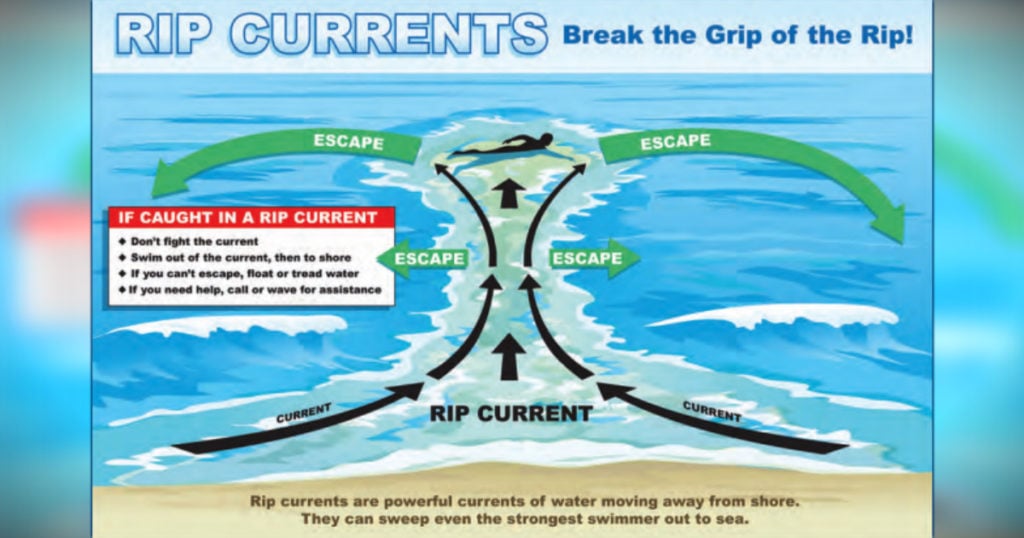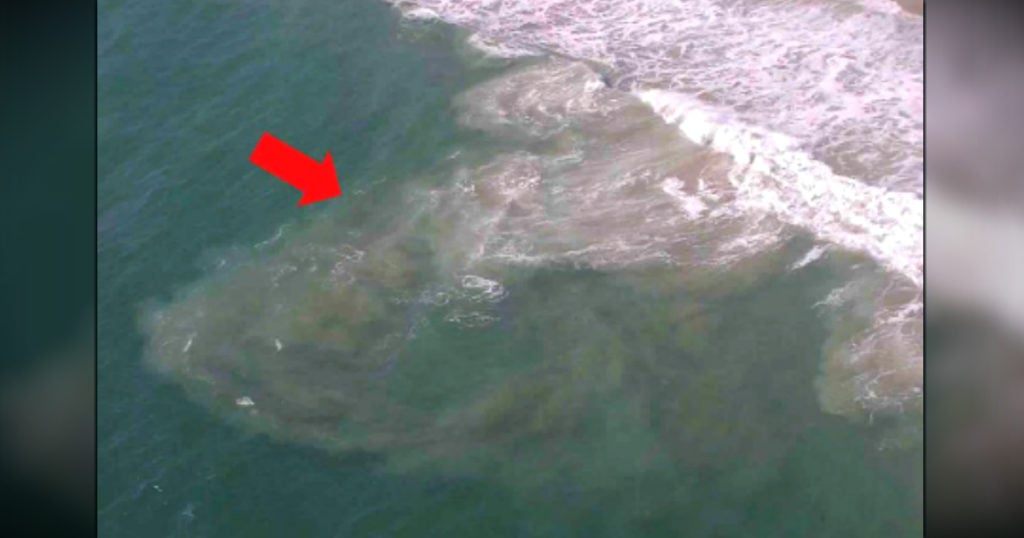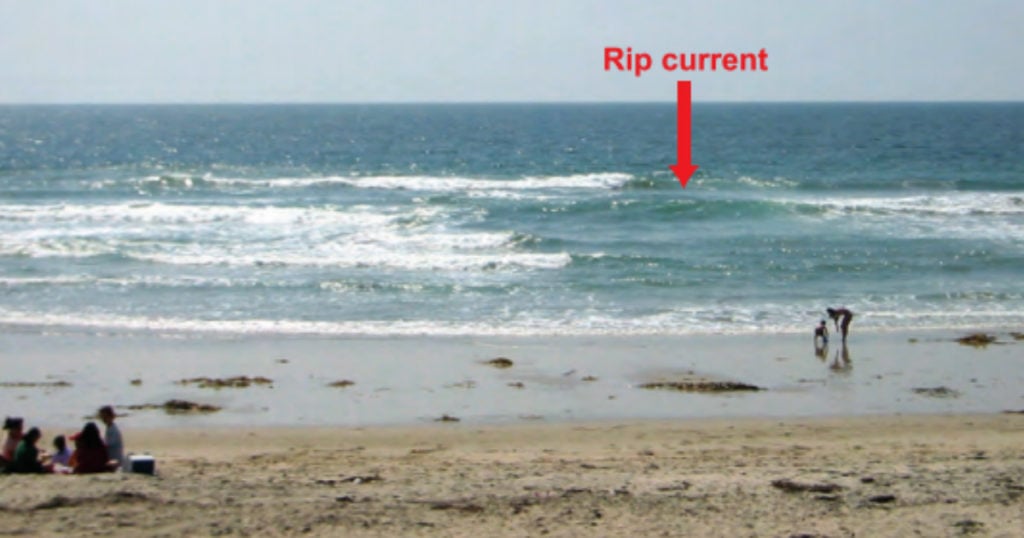People naturally start flocking to the water in the warmer months of the year. But it’s important to keep rip current safety in mind. These forceful tides have the power to turn a fun day at the beach tragic in no time.
Rip Current Safety — What It Is
Rip currents — tunneled currents of water flowing away from the shore — are basically always present in some form. But the strength of the waves helps determine just how strong a rip current is.
RELATED: Mom Shares Story Of Baby's Near Drowning As Water Safety Reminder
Water piles up wave after wave, and with nowhere else to go, it moves horizontally. Once it finds a weak spot in the oncoming waves, the excess water flows back out to the ocean, creating a rip current (sometimes mistakenly called a rip tide).
Rip currents move quickly. On average, they travel about 1- to 2- feet per second. But some have been measured to move as fast as 8-feet per second. That’s faster than an Olympic swimmer!
WATCH: Scientists Show How A Rip Current Can Sweep Swimmers Out To Sea
With that kind of force, rip currents can easily sweep even the strongest swimmer quickly out to sea. In fact, about 80% of rescues performed by beach lifeguards are because of rip currents. And that’s why it’s so important for all beachgoers to know about rip current safety.
Tragedy Strikes The Beach
Rip current safety really isn’t something to take lightly. Sadly, there are plenty of stories where people have lost their lives. And all because they got trapped in a rip current.
In 2018, within the first week of June, popular North Carolina vacation destination the Outer Banks saw 3 deaths in just 4 days because of rip currents.
Yesterday 2 families lost loved ones on vacation on the #OBX The 3rd fatality off our beaches in 4 days. It’s important to understand the power of our ocean. It’s not a lake. It’s not a pool. It’s a dynamic, always changing unforgiving force of nature #LoveTheBeachRespectTheOcean pic.twitter.com/A3OqSKfYDN
- Dare County EM (@DareCountyEM) June 7, 2018
Earlier in the season, tragedy shattered a family vacation in the Outer Banks when a rip current swept away a 4-year-old boy. And the little boy wasn’t even swimming when the accident occurred.
RELATED: Heroic Mom Gives Her Life To Save 4-Year-Old Son From Rough Waves
Instead, he and his mom were enjoying an afternoon walk on the beach. As they strolled through the surf’s ankle-deep water hand-in-hand, a big wave (some outlets are even calling it a rogue wave) suddenly knocked the two of them down. The wave ripped the boy from his mother’s grasp and quickly carried him away.
Mom scrambled back up and frantically looked for her young son. But he was nowhere to be found. After five days of looking, search crews finally found the boy’s body and confirmed his parents’ worst fear.
It’s a terrible tragedy that no one ever wants to see happen. And the real-life news story of tragedy just serves to highlight the serious danger rip currents present.
Rip Current Safety — Why They’re Dangerous
Rip currents are very common. They are found on most surf beaches every day, including Great Lakes beaches. Here are some things that make them such a risk:
- Rip currents can be tricky to spot, especially from ground level.
- People mistakenly assume nice weather on the beach guarantees safe surf conditions. However, it’s often during the best weather that multiple deaths occur. That’s because, while it’s sunny on the shore, there may still be large storms far out at sea generating long-period swells, which then form rip currents back on the beach.
- Many visitors to beaches are on vacation and may have limited or no knowledge of/experience with rip currents.
- Rip currents catch most people off-guard. One minute, you’re playing in the surf and the next, a current is rapidly sweeping you out to sea.
- People’s first instinct is usually to swim directly against the current. But even strong swimmers aren’t likely to outswim a rip current! Instead, the effort simply leaves the swimmer exhausted and at risk of drowning.
Rip Current Safety — Tips For Spotting A Rip Current
Rip currents are easier to spot from an elevated view, such as a pier or raised beach access.
It’s tougher to see them from the beach or surf. But here are a few characteristics you may notice:
- The water in a rip current often looks darker than the surrounding water.
- Since rip currents transport sand, the water in them may look dirty or muddy when compared to the water around them.
- You may notice sea foam extending further out into the surf in a rip current.
- You may notice choppy, churning water or a break in the incoming wave pattern.
- Polarized sunglasses help reduce the sun’s glare, so they can help make it easier to spot a rip current from the shore.
Rip Current Safety — Tips To Help Steer Clear
Since rip currents are so hard to spot from the beach or water, here are some other safety tips:
- Make sure you know how to swim before going near the water
- Don’t ever go swimming alone
- Only swim at beaches where there are lifeguards on duty
- Always check the surf conditions, either by asking the lifeguards or by checking the latest National Weather Service forecast for local beach conditions
RELATED: Mom Warns About Dangers Of Dry Drowning
Rip Current Safety — Tips For Escaping
If the worst happens and you find yourself caught in a rip current, here are some tips for escaping:
- Try not to panic
- Call out for help, especially if you’re a weak swimmer
- Don’t fight the current. Instead, swim sideways/parallel to the shoreline until you are free from the pull of the current.
- Take breaks from swimming by floating on your back or treading water. You want to try and save your energy as much as possible for when you’re free of the current.

Credit: Dave Brenner/Michigan Sea Grant
For more information about rip current safety, you can always check out the free online Break the Grip of the Rip training.
We should all appreciate the beauty of God’s creations, but be sure to respect the dangers they may hold, too!
WATCH: Love The Beach, Respect The Ocean PSA
h/t: Washington Post / NOAA National Weather Service
Featured Image Credit: The Outer Banks Voice/Rob Morris
YOU MAY ALSO LIKE: Cameras Show Boy Trapped Underwater For Nearly 8 Minutes








